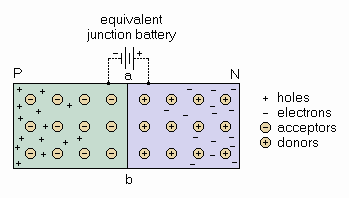| Transistor Basics is a free introductory textbook on transistors and their basic applications. See the editorial for more information.... |

|

Home  Basic Semiconductor Physics Basic Semiconductor Physics  Transistor Germanium Properties Transistor Germanium Properties  Potential Hills Potential Hills |
||






|
||
|
Potential HillsAuthor: Leonard Krugman
Fig. 1-4. P-N junction at equilibrium. Alone, either P- or N-type germanium is capable of bi-directional current flow. This means that reversing the battery will reverse the direction of the current flow, but will not affect the magnitude of the current. When P- and N-type germanium are joined as shown in Fig. 1-4, an effective rectifying device is formed. The junction, designated ab, is called a P-N junction. In the illustration the + and — signs represent holes and electrons, respectively; and the + and — signs with circles around them represent the donor and acceptor atoms, respectively.
|
||
Home  Basic Semiconductor Physics Basic Semiconductor Physics  Transistor Germanium Properties Transistor Germanium Properties  Potential Hills Potential Hills |
||
Last Update: 2010-11-17


